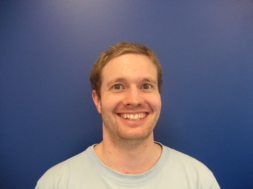Microscopic properties of the super hydrophobic state
Promotion date: 3 December 2008
Thesis advisor: Prof. dr. Frieder Mugele
| A super hydrophobic surface, is a hydrophobic surface with a micro scale texture. A drop of water floats on top of the texture like a fakir on a bed of nails, thereby forming microscopic liquid-gas interfaces that span between the ridges of the texture. The shape of the liquid-gas interfaces plays an important role in the stability of the super hydrophobic state. These interfaces are measured and studied, by using optical diffraction. Thereby fundamental questions are answered, that concern the stability of the super hydrophobic state. |
When did this method emerge as a tool for your research?
The initial focus was more in general on nano-confined liquids. Soon I was convinced that using optical refraction, was a feasible way of measuring the liquid/gas interfaces.
At first it sounded like a revolutionary idea, completely new. But I saw no real reason why it wouldn't work. I was really driven to show this opportunity, and after one weekend I had my first measurement results. These were sure results. It provided a good ground to choose a direction and strategy to proceed further. After that, it took three months to come up with the first important results.
It even provided a patent...
We discovered properties of super hydrophobic surfaces that were completely unexpected. It was proven to be possible to measure sound-waves, by using this kind of diffraction measurement in this state. From that, an ultra-sound patent was described. In addition to the scientific results and publications, this part was a kind of gift to me.
Did it cost you a lot of extra work, this patent-story?
No, it didn’t. MESA+ helped a great deal. The real work was done by specialists, Arnold & Siedsma, an external patent office. I had to give them input, and we had some intensive discussions, on how to formulate all this.
It did not provide me any stress, whatsoever. On the contrary, I learned what it takes to make a patent work. Being into this process was a nice and interesting learning experience for me.
What is characteristic of the way MESA+ works?
The concept of "sharing", of facilities and technological knowledge, is brought to the top here. The focussed ion beam, for example, is a great device: a nano-meter drilling instrument, that costs up to half a million dollars. The technicians from the Optical Sciences group, especially Frans Segerink, knew immediately how to use this instrument for my purposes which were very special. They were very quick to establish the direction of research. They are always flexible, because so many different groups within MESA+ use these, and other, cleanroom facilities. At MESA+ all researchers are extremely open minded, and almost no bureaucratic hurdles do exist, in making use of special equipment. That is stimulating.
Can MESA+ do things better still?
Well, maybe. In the exchange of knowledge and ideas on the student level, for example, more can be done. The MESA+ day must definetely be kept. But this is meant more for the PhD-students and experienced researchers. Something similar can be done for the students involved, I believe. They can learn a great deal from the PhD's, as they possess the most direct and practical knowledge about the projects they are involved in.
What are your future plans?
I received a postdoc position at the university of Stuttgart, a modern institution that also has a long tradition. I am going to work in a big group which is known for its strong publications in science. My subject will be quantum computation. The new job will involve a lot more teaching. It is a completely new job, but at my age you have to be flexible.

